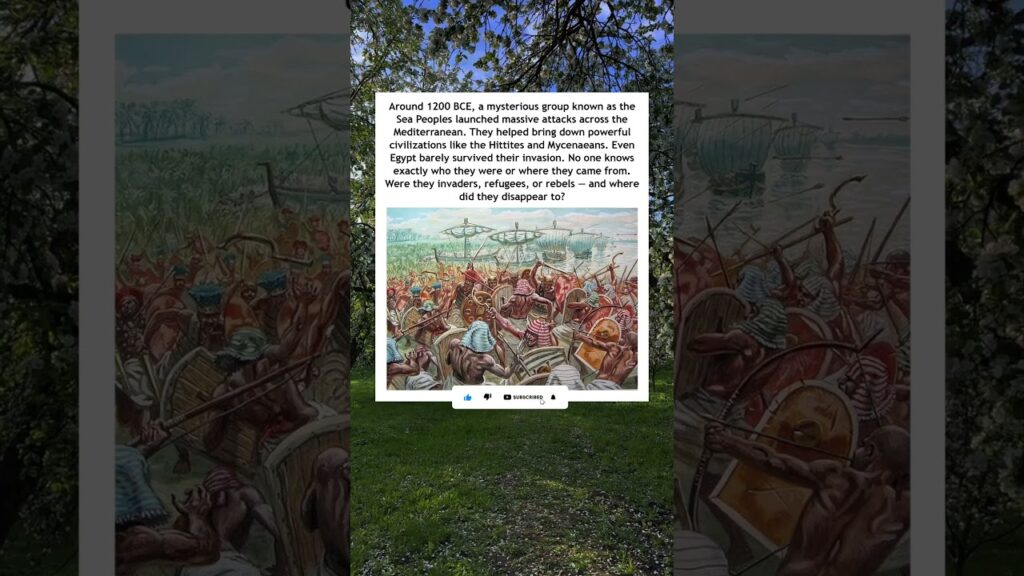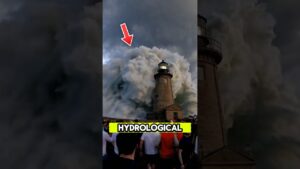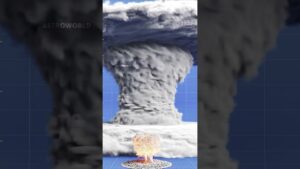
Around 1200 BCE, the ancient world was shaken by a catastrophe so widespread and devastating that historians call it “the worst disaster in ancient history.” In just a few decades, some of the greatest civilizations of the Late Bronze Age—including the Hittite Empire, Mycenaean kingdoms, Ugarit, Kassites, and Amorite city-states—collapsed and vanished from the map. What followed was a period of chaos, cultural regression, and fragmentation often referred to as the Dark Age of the ancient Mediterranean. At the heart of this turmoil stood a mysterious and still largely unidentified force known as the Sea Peoples.
Mentioned in Egyptian records, especially in the inscriptions of Pharaoh Ramesses III, the Sea Peoples were described as marauding groups who attacked by both land and sea, destroying cities, toppling kingdoms, and bringing down centuries-old trade networks. Egypt managed to repel them, but only barely—and even then, the New Kingdom was left weakened. No one knows exactly who the Sea Peoples were, though ancient texts name several tribes—such as the Sherden, Peleset, Lukka, and Shekelesh. Their origins remain hotly debated: some believe they came from the Aegean or western Anatolia, others from the Balkans or even as far as Italy. They may have been a mix of displaced migrants, former mercenaries, raiders, or climate refugees—perhaps all of the above.
But the Sea Peoples were just one piece of a much larger puzzle. Scholars believe that the collapse of Bronze Age civilizations was caused by a perfect storm of factors. Climate change and prolonged drought may have triggered famine and mass migrations. Earthquakes and even volcanic eruptions could have devastated key regions. A general systems collapse—the breakdown of complex interdependent economies, fragile bureaucracies, and elite-driven societies—left cities vulnerable to revolt and invasion. Technological changes in warfare, such as the widespread use of iron weapons and new fighting tactics, may have outpaced traditional military systems. Trade routes crumbled, literacy declined, and monumental architecture ceased across much of the Mediterranean.
Yet not all was lost. Some civilizations, like Assyria, Egypt’s New Kingdom, Elam, and Phoenicia, managed to survive—albeit transformed. The collapse marked the end of the old world and the slow, painful birth of a new one that would eventually give rise to Classical Greece, the Iron Age empires, and new global powers.
The Sea Peoples remain an enduring enigma—symbols of a turbulent era whose full story is still buried beneath layers of myth, ruin, and silence.
#SeaPeoples, #BronzeAgeCollapse, #AncientMystery, #LateBronzeAge, #LostCivilizations, #AncientWarfare, #HistoricalEnigma, #AncientInvasion, #UnsolvedHistory, #EgyptianHistory, #AncientMediterranean, #MysteriousInvaders, #HistoryPuzzle, #AncientCollapse, #SeaPeoplesMystery, #AncientWorld, #ForgottenEmpires, #AncientHistoryFacts, #HistoryMysterious, #AncientDisaster, #PrehistoricWarfare, #CulturalCollapse, #1200BCE, #CollapseOfCivilizations,
Sea Peoples, invaders, Egypt, Mediterranean, mystery, collapse, civilizations, 1200 BCE, warfare, raiders, unknown, ships, migration, culture, destruction, Bronze Age, fall, empires, Hittites, Mycenaeans, refugees, rebels, warriors, battles, chaos, famine, disaster, unknown origins, collapse theory, unrest, climate, ancient, history, attackers, mystery group, lost, society, conquest, conflict, pharaohs, maritime, ancient world, Egypt records, nomads, unknown people, vanished, invasion, destruction era, migration crisis, ancient enigma, seafarers, lost tribes
Sea Peoples mystery, Bronze Age invaders, collapse of Mycenae, fall of Hittite Empire, Late Bronze Age crisis, Egypt Sea Peoples battle, Ramses III inscription, ancient naval raiders, ancient migration mystery, collapse of civilizations, maritime invaders, Bronze Age warfare, unknown seafarers, Mediterranean invaders, destruction of cities, ancient raiders, unsolved ancient mystery, Bronze Age collapse theories, pre-Greek raiders
Who were the Sea Peoples, Sea Peoples origin theory, Bronze Age collapse explained, Sea Peoples documentary, Late Bronze Age invasions, Sea Peoples vs Egypt, ancient Mediterranean invaders, fall of Bronze Age civilizations, Sea Peoples archaeological evidence, 1200 BCE collapse, Sea Peoples theories, Sea Peoples Ramses III, collapse of Mycenaean Greece, Sea Peoples Egypt battle, Medinet Habu Sea Peoples, Sea Peoples mystery solved, where did the Sea Peoples go, Late Bronze Age mystery, Sea Peoples map, ancient civilization collapse, Sea Peoples timeline, Sea Peoples ancient history, Mediterranean collapse 1200 BCE, Sea Peoples climate refugees, Sea Peoples war tactics, Sea Peoples in history, unsolved ancient mystery Sea Peoples, Sea Peoples documentary YouTube, Sea Peoples migration, who attacked ancient Egypt, Hittite Empire collapse, ancient seafaring raiders, origin of Sea Peoples, Sea Peoples lost civilization
source




Around 1200 BCE, the ancient world was shaken by a catastrophe so widespread and devastating that historians call it “the worst disaster in ancient history.” In just a few decades, some of the greatest civilizations of the Late Bronze Age—including the Hittite Empire, Mycenaean kingdoms, Ugarit, Kassites, and Amorite city-states—collapsed and vanished from the map. What followed was a period of chaos, cultural regression, and fragmentation often referred to as the Dark Age of the ancient Mediterranean. At the heart of this turmoil stood a mysterious and still largely unidentified force known as the Sea Peoples.
Mentioned in Egyptian records, especially in the inscriptions of Pharaoh Ramesses III, the Sea Peoples were described as marauding groups who attacked by both land and sea, destroying cities, toppling kingdoms, and bringing down centuries-old trade networks. Egypt managed to repel them, but only barely—and even then, the New Kingdom was left weakened. No one knows exactly who the Sea Peoples were, though ancient texts name several tribes—such as the Sherden, Peleset, Lukka, and Shekelesh. Their origins remain hotly debated: some believe they came from the Aegean or western Anatolia, others from the Balkans or even as far as Italy. They may have been a mix of displaced migrants, former mercenaries, raiders, or climate refugees—perhaps all of the above.
But the Sea Peoples were just one piece of a much larger puzzle. Scholars believe that the collapse of Bronze Age civilizations was caused by a perfect storm of factors. Climate change and prolonged drought may have triggered famine and mass migrations. Earthquakes and even volcanic eruptions could have devastated key regions. A general systems collapse—the breakdown of complex interdependent economies, fragile bureaucracies, and elite-driven societies—left cities vulnerable to revolt and invasion. Technological changes in warfare, such as the widespread use of iron weapons and new fighting tactics, may have outpaced traditional military systems. Trade routes crumbled, literacy declined, and monumental architecture ceased across much of the Mediterranean.
Yet not all was lost. Some civilizations, like Assyria, Egypt’s New Kingdom, Elam, and Phoenicia, managed to survive—albeit transformed. The collapse marked the end of the old world and the slow, painful birth of a new one that would eventually give rise to Classical Greece, the Iron Age empires, and new global powers.
The Sea Peoples remain an enduring enigma—symbols of a turbulent era whose full story is still buried beneath layers of myth, ruin, and silence.